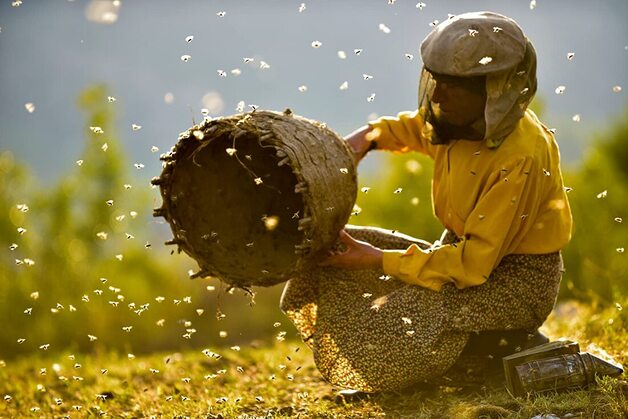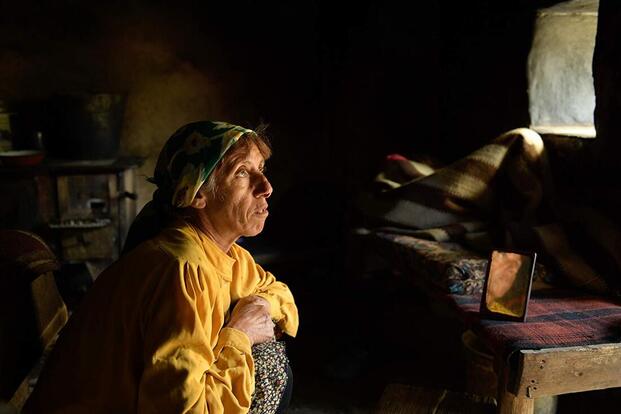HONEYLAND
****
Directors: Tamara Kotevska and Ljubomir Stefanov
Screenwriters: Tamara Kotevska and Ljubomir Stefanov
Principal cast:
Hatidze Muratova
Nazife Muratova
Hussein Sam
Ljutvie Sam
Country: Republic of North Macedonia
Classification: M
Runtime: 89 mins.
Australian release date: 5 March 2020.
The unlikely ‘star’ of Honeyland is a 50-something North Macedonian woman of Turkish background with a face like an Easter Island moai and a cheery disposition. Hatidze Muratova needs that positive outlook because she lives with her frail, house-bound and partially-blind mother Nazife in a deserted mountain village, eking out a precarious existence by harvesting honey from the region’s wild bees. Their house has no running water or electricity and no sealed roads approach it so, despite the fact that they are only 20 kilometres from the nearest town, the couple is completely cut off from human company, although they do have a dog and a cat for companionship. Hatidze, the last daughter in the family, has never married because, in keeping with tradition, she has remained at home to look after her mother in her old age.
Documentarians Tamara Kotevska and Ljubomir Stefanov gently capture the rhythm of her simple existence and her nurturing respect for the bees and their cameras are there on the day a large, itinerant family of cattle herders arrives on her doorstep. Hussein and Ljutvie Sam and their seven boisterous children quickly set up camp in one of the deserted buildings and go about their busy, noisy existence. Gradually, the kids start to visit Hatizde and, before long, she is teaching the Sams about her traditional way of bee-keeping. She has one cardinal rule, however, and that is that you must never take all the honey from the hives, a mantra she gently croons to the bees, “half for me, half for you.” Hussein, though, has a lot of mouths to feed and a buyer constantly pushing him to harvest more and more, which leads Hatizde to the brink of disaster.
It’s astonishing that Honeyland, superficially a documentary about a disappearing way of life in the heart of 21st century Europe, can contain so many important lessons about the global economy, capitalism and overconsumption, climate change and mass extinction, when none of these subjects are openly canvassed. Indeed, the film was originally intended to be a short report on life in the area around the town of Lozovo in Central North Macedonia but when the filmmakers stumbled across Hatizde and her mum they knew they had struck filmic gold. The fact that the Sams became part of the story later was a further piece of serendipity and the team of six ended up shooting some 400 hundred hours of footage over three years. Kotevska and Stefanov whittled this material down visually, without relying on language, because, they explained, “The families [in the village] use an ancient Turkish vernacular, so the film is driven by visual narration rather than dialogue, the characters are understood through their body language and their relationships, and their emotions.” It’s an approach that has served Honeyland well, and the fly-on-the-wall documentary has been almost universally praised. Indeed, it is the first doco in history to be nominated for both Best Documentary Feature and Best International Feature Film at the Academy Awards. While it didn’t pick up those awards, it has won many others, particularly for the glorious cinematography of Fejmi Daut & Samir Ljuma, all filmed in natural light. Go for its visuals and extraordinary locations if nothing else but I suspect you’ll stay for the lessons to be learnt from the snaggle-toothed sage Hatizde. She has something to teach us all.
Screenwriters: Tamara Kotevska and Ljubomir Stefanov
Principal cast:
Hatidze Muratova
Nazife Muratova
Hussein Sam
Ljutvie Sam
Country: Republic of North Macedonia
Classification: M
Runtime: 89 mins.
Australian release date: 5 March 2020.
The unlikely ‘star’ of Honeyland is a 50-something North Macedonian woman of Turkish background with a face like an Easter Island moai and a cheery disposition. Hatidze Muratova needs that positive outlook because she lives with her frail, house-bound and partially-blind mother Nazife in a deserted mountain village, eking out a precarious existence by harvesting honey from the region’s wild bees. Their house has no running water or electricity and no sealed roads approach it so, despite the fact that they are only 20 kilometres from the nearest town, the couple is completely cut off from human company, although they do have a dog and a cat for companionship. Hatidze, the last daughter in the family, has never married because, in keeping with tradition, she has remained at home to look after her mother in her old age.
Documentarians Tamara Kotevska and Ljubomir Stefanov gently capture the rhythm of her simple existence and her nurturing respect for the bees and their cameras are there on the day a large, itinerant family of cattle herders arrives on her doorstep. Hussein and Ljutvie Sam and their seven boisterous children quickly set up camp in one of the deserted buildings and go about their busy, noisy existence. Gradually, the kids start to visit Hatizde and, before long, she is teaching the Sams about her traditional way of bee-keeping. She has one cardinal rule, however, and that is that you must never take all the honey from the hives, a mantra she gently croons to the bees, “half for me, half for you.” Hussein, though, has a lot of mouths to feed and a buyer constantly pushing him to harvest more and more, which leads Hatizde to the brink of disaster.
It’s astonishing that Honeyland, superficially a documentary about a disappearing way of life in the heart of 21st century Europe, can contain so many important lessons about the global economy, capitalism and overconsumption, climate change and mass extinction, when none of these subjects are openly canvassed. Indeed, the film was originally intended to be a short report on life in the area around the town of Lozovo in Central North Macedonia but when the filmmakers stumbled across Hatizde and her mum they knew they had struck filmic gold. The fact that the Sams became part of the story later was a further piece of serendipity and the team of six ended up shooting some 400 hundred hours of footage over three years. Kotevska and Stefanov whittled this material down visually, without relying on language, because, they explained, “The families [in the village] use an ancient Turkish vernacular, so the film is driven by visual narration rather than dialogue, the characters are understood through their body language and their relationships, and their emotions.” It’s an approach that has served Honeyland well, and the fly-on-the-wall documentary has been almost universally praised. Indeed, it is the first doco in history to be nominated for both Best Documentary Feature and Best International Feature Film at the Academy Awards. While it didn’t pick up those awards, it has won many others, particularly for the glorious cinematography of Fejmi Daut & Samir Ljuma, all filmed in natural light. Go for its visuals and extraordinary locations if nothing else but I suspect you’ll stay for the lessons to be learnt from the snaggle-toothed sage Hatizde. She has something to teach us all.

